This was published 3 years ago
Disgust, joy, fear: Why Australia’s work at the Venice Biennale has everyone talking
By Rob Harris
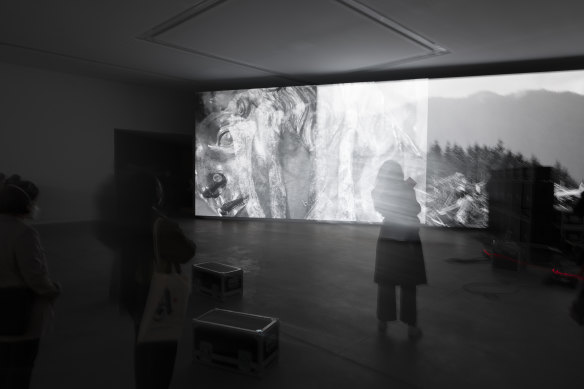
Marco Fusinato’s Desasters at tje Venice Biennale.Credit: Andrea Rossetti
Marco Fusinato has a cough. It’s one of those dry coughs that linger at the top of the throat and rears halfway through a sentence. Constant sipping of bottled water is required to speak for any length of time.
The 58-year-old caught COVID-19 in the fortnight before his exhibition, Desastres, launched as Australia’s contribution to this year’s Venice Biennale. There’s a touch of irony to it all. His work, which he will perform live for 200 days at the so-called Olympics of the art world, was heavily influenced by the frustrations and tensions of more than 260 days in locked-down Melbourne.
“It was terrible timing,” he says. “We couldn’t obviously come and do a site visit and I was just isolating in an apartment in this city where you just want to be outside. But then again, it could have been this week, couldn’t it?”
The project is the talk of the village-like atmosphere that has been created at the Giardini over decades. The world’s longest-running major survey of contemporary art, the 59th Biennale, has reconvened after it was cancelled two years running because of the pandemic.
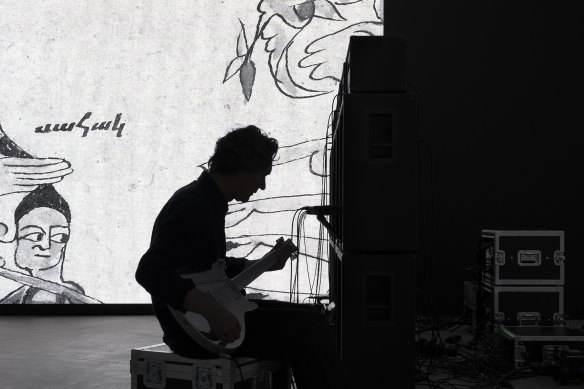
Marco Fusinato will perform live for 200 days.Credit: Andrea Rossetti
Everyone seems to have a view about Australia’s contribution and this suits Fusinato. He doesn’t care what emotions he evokes, he wants people to feel like they’re alive. “That they have a pulse,” he says.
Walk into the Australian Pavilion, a design dubbed the “mysterious black box”, and you’re confronted with high-intensity sound and bright, flashing lights. In the corner, with his back turned to viewers, is Fusinato, using an electric guitar to improvise slabs of noise, saturated feedback and discordant intensities. This triggers a deluge of seemingly disconnected images to be flashed onto a freestanding floor-to-ceiling LED wall.
If you’re an anxious person it can be confronting. It’s loud, an assault on your senses. I felt underlying angst, others felt elation or frustration or despair. But no one, it seems, leaves without feeling something.
“There is no theme as such, rather the immersive encounter with sound and image is open for the audience to interpret and make sense of,” Fusinato says. “The intent is to create some kind of hallucination, elation in disorientation and exhaustion from confusion.”
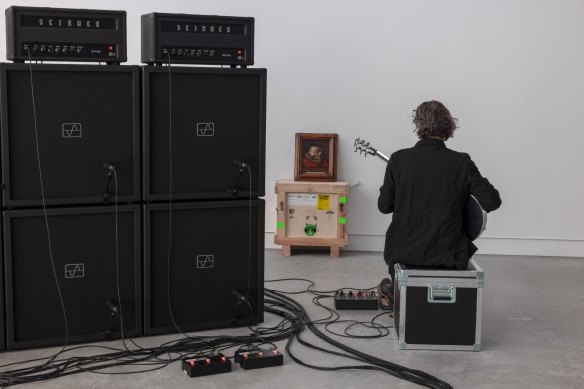
Marco Fusinato’s work was created during COVID-19 lockdowns.Credit: Andrea Rossetti
One moment on the screen there’s an image of a tray of dead birds, then a power plant. A press photo of an indistinct war zone followed by a ghoulish medieval painting of a severed head. Vomiting cats and defecating dogs. Sometimes you’ve only just worked out what the image is when it has disappeared. There are thousands and thousands.
The work is the culmination of several interests and projects. The visual content comes from a vast archive collated by the artist, a product of scouring through online image searches for the word “disasters”, first in English and then in French and Spanish. They were originally downloaded but later photographed on his iPhone off the computer screen.
The images are those which Fusinato thinks are, in some way, “f---ked up”.
“It’s just instinctual,” he says. “When I see them one against the other they’re confounding or contradictory. And so, they create a certain tension. The idea is for the audience when they come in is that you might see one you’re attracted to but the person with them will see something else. So, it’s about perception.”
For much of its creation, Fusinato worked under intense conditions, stuck in a room at home, unable to enter his studio or collaborate in person.
“I was stuck in a bedroom, locked out of my studio. I had to do something or I’d go insane,” he says. “Creating a score was a way to make tangible the idea of image as sound; the score as a proposition.”
But I can’t get to Venice!
You can follow the durational performance via the Instagram channel, @desastres_desastres, and the project’s website, where samples of Fusinato’s performance are released daily.
The name of the project was influenced by his favourite Japanese doom metal band Corrupted. They are from Osaka yet all their song titles, lyrics and graphic design are in Spanish. It’s also a reference to the context in which Spanish artist Franciso Goya made his series Los Desastres de la Guerra. He was deaf from illness, banished to a farmhouse, making the series from his imagination.
“And there I was, trapped in a bedroom making a work for the other side of the world by staring down a portal,” he says.
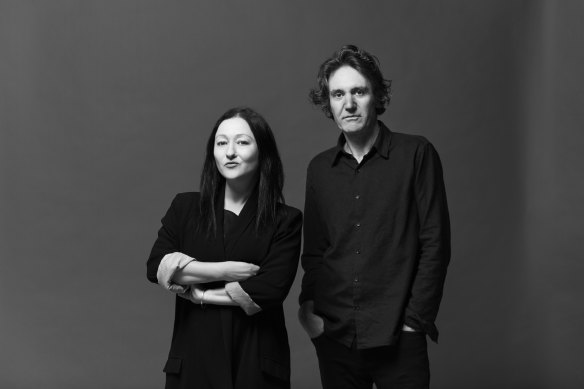
Curator Alexie Glass-Kantor and contemporary artist Marco Fusinato.Credit: Zan Wimberley
Fusinato’s collaborator on the work is curator, Alexie Glass-Kantor, the executive director of Artspace in Sydney. Glass-Kantor first came across Fusinato in 1999 when she reviewed one of his Sydney shows for The Sydney Morning Herald. Looking back, she says it was a bit of a “hatchet job” and she’d “misunderstood it”.
However, they soon became close collaborators and have worked together on several projects over the 20 years that followed. She says the show had to be a “monster” because “these are monstrous times”.
The question she says they wanted to ask: “Do you have a f---ing pulse. Can you feel something?”
“This is not a safe project. We didn’t want to do a safe work. We care that you respond. We care that everyone feels a sense that it belongs to them, but you don’t have to like it.”
Glass-Kantor says the work is a “banquet of images” that range from the “benign to the blatant, absurd, twisted, sublime, bone-crushing and tense”.
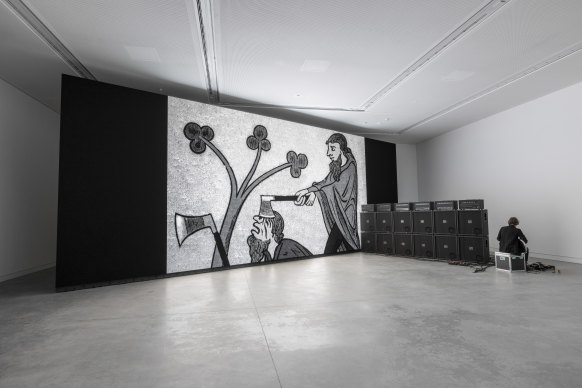
“There is no theme as such, rather the immersive encounter with sound and image,” Marco Fusinato says.Credit: Andrea Rossetti
To fully understand the work, she says, you need to understand Fusinato.
Fusinato’s mother and father were born in small villages just under 100km north of Venice at the foothills of the Dolomite ranges. The majority of people in the region were pre-industrial agricultural farmers or peasants who had no electricity, plumbing or motor vehicles.
“It really forms a part of who he is and what he does,” she says.
Fusinato Snr was drafted into the Italian army during World War II and was sent to Greece, Albania and the Russian front where he was shot. Whilst he was recovering, his colleagues were killed while trying to make an advance. He eventually made his way back home on foot from Yugoslavia.
“I’ve spent a lot of time in the family home in Arsiè over the years and have maintained lifelong relationships with the people there of my generation,” Fusinato says.
“There’s a deep historical connection through shared histories and language. Our parents and their parents’ parents sang the same songs and cultivated the same fields, walked the same mountains.”
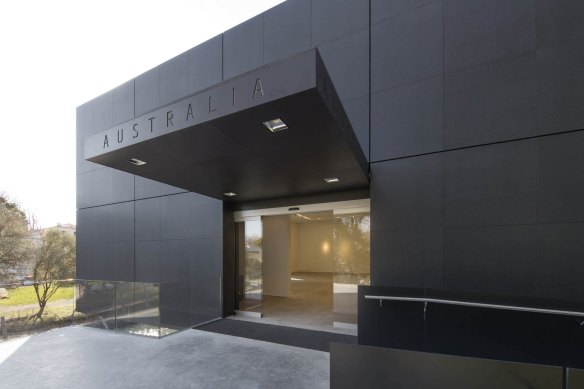
The Australian Pavilion at the Venice Biennale.
He still speaks the regional language which is rapidly dying out. One of the few places you can hear it now is in nursing homes, as centuries-old oral traditions, passed down through the generations slowly disappear. Italians mainly speak what he calls “proper Italian” now - which makes him feel pretentious or fake, like you’re either “bullshitting or speaking to the Pope”.
“My parents never assimilated even after migrating to Australia in 1960. They never learned to speak English fluently or read and write it; they only ever spoke Bellunese,” Fusinato says.
It was his first language too, the one they spoke at home, as he grew up in the working-class suburb of Noble Park in Melbourne’s southeast. It’s the migrant experience of life in the 1970s and 1980s that shaped Fusinato and his work.
“The Anglosphere of Australia at that time was vicious. Well, it still is. I think it’s because of this that I’ve always had empathy for communities who sit outside the mainstream,” he says.
It drew him to punk music - the anarchist punk band Crass - underground culture and alternative spaces. But now he’s back to the same place his parents migrated from to represent the country they migrated to.
“There’s a collapse of time,” he says. “Australia, like Italy is a recent construct. I was born on stolen land disguised as some European outpost. I’m at the end of my ancestors’ ancient culture, and simultaneously a parasite on unceded land.”
And so, every day of the Biennale, Fusinato will perform during opening hours until November. He says each no day will be the same.
“For me, the appeal of being an artist or musician has always been that it is the area with the least rules and regulations,” he says.
“Improvised music is spontaneous; for me, there’s no difference between doing the soundcheck and playing the set.”
Rob Harris travelled to Venice with support from the Australia Council.
A cultural guide to going out and loving your city. Sign up to our Culture Fix newsletter here.
To read more from Spectrum, visit our page here.